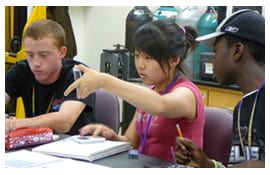What is a MWM Module?
|
Each module is a supplemental unit that takes 1 to 3 weeks of class time (approximately 10 hours, on average) Most of the science concepts are presented in explanations that are are supported with easy to understand analogies, common examples, and clear illustrations. The concepts are broken down into small pieces and presented in a logical sequence that progresses from simple to complex. All of the modules feature scientific investigations that require students to declare their ideas by formulating hypotheses or making predictions. These hypotheses or predictions are tested with simple manipulatives that involve making observations, taking measurements, analyzing data, and presenting conclusions. Most of the mathematics content is embedded in the various investigations that the students conduct (e.g., measurements, data analysis, graphing the relationship between two variables). The materials do not attempt to teach the mathematics that is required to quantify phenomena, to perform calculations, to analyze data, or to present results. Engineering concepts and ways of thinking can be found in the culminating design problems at the end of each module. They all require students to apply what they have learned in previous lessons and laboratory activities to the development of a solution of a practical problem. The problems are typically presented in the context. |
MWM Module Components
MWM Kits
As a service of busy teachers, Activity Kits for each of the modules are provided and can be purchased. The kits contain the basic materials that a class of 24 to 32 students (8 groups of 3-4 students) will need to run the activities and design projects outlined in the modules.
The Basic Starter Kits* are assembled by the module developer and contain materials that have been successfully field-tested in actual classrooms. Basic Starter Kits consists of consumable and non-consumable supplies the are necessary for module activities but are not standard laboratory supplies.
The Refill Kits* allow teachers to replenish the consumable materials without having to purchase another starter kit.
Example of what to order for a class of 24-32 students:
- 1 teacher edition
- 24-32 student editions
- 1 starter kit, which contains consumable and non-consumable materials
For more information regarding MWM Activity Kits, please contact mwm@northwestern.edu.
*Note: Activity Kits DO NOT include Teacher Edition or Student Edition Manuals. Manuals must be ordered separately.
Student Edition
The student (pupil) edition (PE) of each module is structured into 4 main parts:
Click on the icons next to the short descriptions to view sample pages.
Activity Features in the Student (Pupil) Edition

Other Features in the PE

Teacher Edition
The TE edition includes the student edition, which allows teachers to follow through the module while also benefiting from the troubleshooting and teaching tips that surround the pages from the student book.
The TE of each module is divided into three major sections (introductory, planning, and appendix), which can be distinguished by page number conventions used in the booklet. Unless otherwise noted, all examples below are from the Smart Sensors Module.
TE Introductory Section |
|
TE Planning Section |
|
TE Appendix Section |

 Focuses on materials science and nanoscale science concepts
Focuses on materials science and nanoscale science concepts









